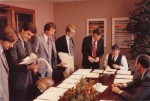 Doug Fairbairn reminds me that today is the 30th anniversary of the funding of VLSI Techology. VLSI was really the first company to embrace the idea that integrated circuits could be designed by people outside the priesthood of the semiconductor companies themselves, what we now call IDMs. The original founders were Jack Baletto, Dan Floyd and Gunnar Wetlesen. Doug Fairbairn would become employee #4 when he went to interview the 3 of them for the infant VLSI Design Magazine (still called Lambda back then) and realized that they needed help in the software area if they were going to succeed as a manufacturing foundry, since there was no way to create a design with what was then available. This was the era when every semiconductor company developed its own tools and not long after the era when every semiconductor company developed its own manufacturing equipment.
Doug Fairbairn reminds me that today is the 30th anniversary of the funding of VLSI Techology. VLSI was really the first company to embrace the idea that integrated circuits could be designed by people outside the priesthood of the semiconductor companies themselves, what we now call IDMs. The original founders were Jack Baletto, Dan Floyd and Gunnar Wetlesen. Doug Fairbairn would become employee #4 when he went to interview the 3 of them for the infant VLSI Design Magazine (still called Lambda back then) and realized that they needed help in the software area if they were going to succeed as a manufacturing foundry, since there was no way to create a design with what was then available. This was the era when every semiconductor company developed its own tools and not long after the era when every semiconductor company developed its own manufacturing equipment.
The lead investors were Evans and Sutherland (the graphics and flight simulator company in Salt Lake City) and Hambrecht & Quist (one of the earlier VCs).
VLSI had an incredible, especially given its limited size, team of software engineers who put together an entire design system in a relatively short time. We were the first generation of PhDs who had learned the Mead-Conway methodology, so the first generation of computer-scientists rather than electrical engineers, who knew how to design a chip. For several years I think we had clearly the best design tools that you could buy. Of course you had to use VLSI to build your silicon to get your hands on them, which was a good business model when VLSI started out but became less tenable as the DMV (Daisy, Mentor, Valid) got going and promoted the idea of software coming from a 3rd party EDA industry with libraries as the link to manufacturing. When it was just DMV, largely used for simple gate-arrays, VLSI was still in good shape since more complex designs required more powerful tools. But when ECAD and SDA merged to form Cadence we suddenly had a whole lot more competition. Every semiconductor manufacturer, especially in Japan but even Intel (I bet you’d forgotten they were in ASIC for a while) entered the ASIC business.
Since they didn’t know what they were doing initially, they could only compete on price. In practice, they weren’t very competent for many years. We would often end up bidding on designs where our price (and LSI Logic’s, the other company founded at almost the same time focused on gate-arrays) were twice the Japanese. “Come back when they fail,” we’d say and usually they would.
I think it was Wilf Corrigan, CEO of LSI Logic, who pointed out that the EDA industry stole all the profit from ASIC. They shipped tools that, in the early days at least, really weren’t very good. But the ASIC manufacturers only made money when the design got through so they ended up incurring all the costs of support. If you look at VLSI Technology over the years, it made money some years, lost money other years but it never generated enough cash to grow organically when you took its capital requirements (we had 2 fabs) into account. At one point, as the ultimate vote of no-confidence in the ability to generate profit, VLSI’s book value was less than the cash in the bank.
I joined VLSI about 18 months later. I think my hire date was June 28th 1982 (and we all got a $100 bonus for July 4th that year, so not a bad start. $100 was worth something back then). I stayed for 16 years eventually sawing off the branch I was sitting on. By then I was running Compass and we were acquired by Avant! I stayed there for 8 hours after the deal finally closed, resigning on a Friday afternoon and starting at Ambit on Monday morning. Good decision.
The non-Compass part of VLSI was eventually acquired by Philips Semiconductors (now NXP) in a hostile takeover in 1999 for $1B.
By some measures, VLSI was a big success: we invented an industry, pioneered various design tools, were successful in PC chipsets, early into wireless and grew from nothing to a $600M (I think) business. But the stock price never went anywhere in 15 years, spending most of its time lingering in the $11 to $15 range. In fact from my personal financial point of view, the most important event was the 1987 stock market crash when all our options were repriced to $4. So once the stock went back to its usual range there was a nice profit.
But I learned an incredible amount about silicon, software development, management. Compared to most people in EDA I like to say I have silicon in my veins. I’m often disturbed by how little about semiconductors EDA people know. It was a great ride.
